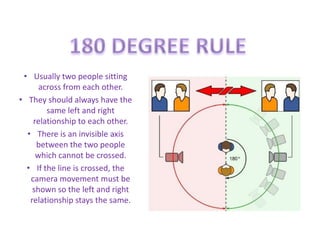
The Four Rules
- 1. • Usually two people sitting across from each other. • They should always have the same left and right relationship to each other. • There is an invisible axis between the two people which cannot be crossed. • If the line is crossed, the camera movement must be shown so the left and right relationship stays the same.
- 2. • A type of edit where you cut back and forth between footage which has been shot simultaneously. • It is usually used for filming conversations and is important to observe the 180 degree rule.
- 3. • Lining up shots so it appears continuous – people, objects and location all appear the same in all shots. • Makes the shots flow.
- 4. • When you include a shot that isn’t in the usual action to tell the audience something about the storyline – like a narrative clue.